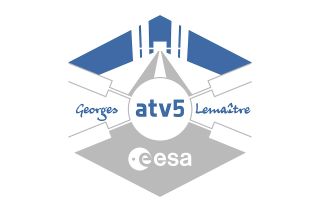Going Out with a (Big) Bang: Final ATV Cargo Ship Space Station-Bound

Europe's line of space freighters is going out with a (big) bang.
Christened the "Georges Lemaître" after the Belgian priest and astronomer who proposed what became the Big Bang theory of the universe's origin, the final European Space Agency (ESA) Automated Transfer Vehicle (ATV) lifted offTuesday (July 29) and immediately became the heaviest vehicle launched by Europe's venerable Ariane 5 rocket.
The 13-ton spacecraft, now on its way to the International Space Station, rose from the ELA-3 pad at the European-run spaceport in Korou, French Guiana at 7:47 p.m. EDT (2347 GMT; 8:47 p.m. local time). The Georges Lemaître will deliver more than seven tons of science experiments, food, supplies and fuel to the space station when it arrives on Aug. 12. [Europe's ATV-5 Space Cargo Ship Mission in Pictures]
There, German astronaut Alexander Gerst will become the last European to open the hatch to a European spacecraft docked to the orbiting outpost. The ATV is being retired in favor of ESA applying its past two decades of design and flight experience to develop a service module for NASA's next-generation crewed space capsule, the Orion.
"In a way it is sad to see that this is already the last one," Gerst said in a preflight interview."But, on the other hand, the technologies that we used for ATV are being used for future vehicles."
The 34-foot-long (10.3 meter) ATV, with its four "X-wing"-arranged solar panels will perform an automated approach to the station's Russian Zvezda service module, where it will remain attached for the next six months.
Europe's last load(stone)
Inside the Georges Lemaître, Gerst and his space station crew mates will find more drinking water than any of the prior four ATVs have supplied, food needed to restock the station's pantry and a number of European, Japanese, and U.S. science experiments.
Get the Space.com Newsletter
Breaking space news, the latest updates on rocket launches, skywatching events and more!
They will also find a small rock that is no stranger to being in space.
In addition to ESA's Electromagnetic Levitator, a device to study heated metals suspended in microgravity, and the Haptics-1 'touchy-feely' joystick to investigate how people feel tactile feedback in space, the cargo freighter also has packed aboard a reconstituted and coated meteorite.
The brainchild of artist Katie Paterson, the iron meteorite naturally fell to Earth 4,000 years ago, crashing into what is now Argentina. In a very literal case of art imitating life, Paterson cast the Campo del Cielo stone and then melted down the rock. Pouring the molten meteorite back into its own cast, Paterson molded the metal back into its original shape.
The meteorite, which ESA then coated to be safely carried aboard the station, is now onboard the Georges Lemaître, returning to space as "non-functional cargo" and, as ESA itself described, is the "oddest item" packed on the ATV.
Complete set

The Georges Lemaître is also flying a commemorative set of patches, lapel pins and DVDs paying tribute to the fleet of five ATVs and their namesakes.
The first Automated Transfer Vehicle, launched in March 2008, was named for French science fiction pioneer Jules Verne. Nearly three years later, the Johannes Kepler lifted off in honor of the German astronomer.
ATV-3, which flew to the station in 2012, was christened for Edoardo Amaldi, the "father of Italian space research" and one of the few scientists who advocated for what later became the European Space Agency.
Launched in June 2013, the fourth ATV was named for the genius Albert Einstein, who is perhaps best known for his theories concerning relativity.
The Georges Lemaître, ATV-5, caps the fleet by honoring a man who advanced our understanding of the beginning of the universe, devising the basis for the Big Bang theory as it is known today.
Follow collectSPACE.com on Facebook and on Twitter at @collectSPACE. Copyright 2014 collectSPACE.com. All rights reserved.
Join our Space Forums to keep talking space on the latest missions, night sky and more! And if you have a news tip, correction or comment, let us know at: community@space.com.

Robert Pearlman is a space historian, journalist and the founder and editor of collectSPACE.com, an online publication and community devoted to space history with a particular focus on how and where space exploration intersects with pop culture. Pearlman is also a contributing writer for Space.com and co-author of "Space Stations: The Art, Science, and Reality of Working in Space” published by Smithsonian Books in 2018. He previously developed online content for the National Space Society and Apollo 11 moonwalker Buzz Aldrin, helped establish the space tourism company Space Adventures and currently serves on the History Committee of the American Astronautical Society, the advisory committee for The Mars Generation and leadership board of For All Moonkind. In 2009, he was inducted into the U.S. Space Camp Hall of Fame in Huntsville, Alabama. In 2021, he was honored by the American Astronautical Society with the Ordway Award for Sustained Excellence in Spaceflight History.
Most Popular



